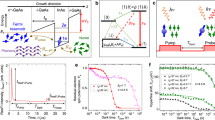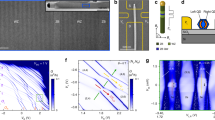Abstract
Electrical control over electron spin is a prerequisite for spintronics spin-based quantum information processing. In particular, control over the interaction between the orbital motion and the spin state of electrons would be valuable, because this interaction influences spin relaxation and dephasing. Electric fields have been used to tune the strength of the spin–orbit interaction in two-dimensional electron gases, but not, so far, in quantum dots. Here, we demonstrate that electrical gating can be used to vary the energy of the spin–orbit interaction in the range 50–150 µeV while maintaining the electron occupation of a single self-assembled InAs quantum dot. We determine the spin–orbit interaction energy by observing the splitting of Kondo effect features at high magnetic fields.
This is a preview of subscription content, access via your institution
Access options
Subscribe to this journal
Receive 12 print issues and online access
$259.00 per year
only $21.58 per issue
Buy this article
- Purchase on Springer Link
- Instant access to full article PDF
Prices may be subject to local taxes which are calculated during checkout





Similar content being viewed by others
Change history
22 November 2011
In the version of this Letter originally published, in the discussion of Fig. 5c on page 514, the fitting function should have been Δ = A|cos(θ − θ0 ± π/2)| + B, and the offsets of θ0 should have been −30 ± 4° and −39 ± 5° for Vsg = −0.5 V and 1.0 V, respectively. These errors have been corrected in the HTML and PDF versions of the Letter.
References
Datta, S. & Das, B. Electronic analog of the electro-optical modulator. Appl. Phys. Lett. 56, 665–667 (1990).
Rashba, E. & Efros, A. Orbital mechanisms of electron-spin manipulation by an electric field. Phys. Rev. Lett. 91, 126405 (2003).
Golovach, V., Borhani, M. & Loss, D. Electric-dipole induced spin resonance in quantum dots. Phys. Rev. B 74, 165319 (2006).
Nowack, K., Koppens, F., Nazarov, Y. & Vandersypen, L. Coherent control of a single electron spin with electric fields. Science 318, 1430–1433 (2007).
Nadj-Perge, S., Frolov, S., Bakkers, E. & Kouwenhoven, L. Spin–orbit qubit in a semiconductor nanowire. Nature 468, 1084–1087 (2010).
Studer, M., Salis, G., Ensslin, K., Driscoll, D. & Gossard, A. Gate-controlled spin–orbit interaction in a parabolic GaAs/AlGaAs quantum well. Phys. Rev. Lett. 103, 027201 (2009).
Nitta, J., Akazaki, T., Takayanagi, H. & Enoki, T. Gate control of spin–orbit interaction in an inverted In0.53Ga0.47As/In0.52Al0.48As heterostructure. Phys. Rev. Lett. 78, 1335–1338 (1997).
Koralek, J. D. et al. Emergence of the persistent spin helix in semiconductor quantum wells. Nature 458, 610–613 (2009).
Kunihashi, Y., Kohda, M. & Nitta, J. Enhancement of spin lifetime in gate-fitted InGaAs narrow wires. Phys. Rev. Lett. 102, 226601 (2009).
Jung, M. et al. Lateral electron transport through single self-assembled InAs quantum dots. Appl. Phys. Lett. 86, 033106 (2005).
Jung, M. et al. Shell structures in self-assembled InAs quantum dots probed by lateral electron tunneling structures. Appl. Phys. Lett. 87, 203109 (2005).
Nakaoka, T., Kako, S., Tarucha, S. & Arakawa, Y. Coulomb blockade in a self-assembled GaN quantum dot. Appl. Phys. Lett. 90, 162109 (2007).
Katsaros, G. et al. Hybrid superconductor–semiconductor devices made from self-assembled SiGe nanocrystals on silicon. Nature Nanotech. 5, 458–464 (2010).
Igarashi, Y. et al. Spin-half Kondo effect in a single self-assembled InAs quantum dot with and without an applied magnetic field. Phys. Rev. B 76, 081303 (2007).
Kanai, Y. et al. Electrical control of Kondo effect and superconducting transport in a side-gated InAs quantum dot Josephson junction. Phys. Rev. B 82, 054512 (2010).
Takahashi, S. et al. Large anisotropy of spin–orbit interaction in a single InAs self-assembled quantum dot. Phys. Rev. Lett. 104, 246801 (2010).
Kouwenhoven, L. et al. Single-Electron Tunneling and Mesoscopic Devices (Nato-Series Kluwer, 1997).
Csonka, S., Hofstetter, L., Freitag, F., Oberholzer, S. & Schönenberger, C. Giant fluctuations and gate control of the g-factor in InAs nanowire quantum dots. Nano Lett. 8, 3932–3935 (2008).
Nilsson, H. A. et al. Giant level-dependent g factors in InSb nanowire quantum dots. Nano Lett. 9, 3151–3156 (2009).
Nilsson, H. A. et al. Correlation-induced conductance suppression at level degeneracy in a quantum dot. Phys. Rev. Lett. 104, 186804 (2010).
Meir, Y., Wingreen, N. & Lee, P. Low-temperature transport through a quantum dot: the anderson model out of equilibrium. Phys. Rev. Lett. 70, 2601–2604 (1993).
Fasth, C., Fuhrer, A., Samuelson, L., Golovach, V. & Loss, D. Direct measurement of the spin–orbit interaction in a two-electron InAs nanowire quantum dot. Phys. Rev. Lett. 98, 266801 (2007).
Sasaki, S., Amaha, S., Asakawa, N., Eto, M. & Tarucha, S. Enhanced Kondo effect via tuned orbital degeneracy in a spin 1/2 artificial atom. Phys. Rev. Lett. 93, 017205 (2004).
Ng, T. K. & Lee, P. A. On-site Coulomb repulsion and resonant tunneling. Phys. Rev. Lett. 61, 1768–1771 (1998).
Glazman, L. & Raikh, M. E. Resonant Kondo transparency of a barrier with quasilocal impurity states. JETP Lett. 47, 452–455 (1988).
Goldhaber-Gordon, D. et al. From the Kondo regime to the mixed-valence regime in a single-electron transistor. Phys. Rev. Lett. 81, 5225–5228 (1998).
Destefani, C., Ulloa, S. E. & Marques, G. Spin–orbit coupling and intrinsic spin mixing in quantum dots. Phys. Rev. B 69, 125302 (2004).
Acknowledgements
The authors acknowledge discussions with R. Sakano. This work was supported by a Grant-in-Aid for Research S (no. 19104007) and A (no. 21244046), MEXT KAKENHI ‘Quantum Cybernetics’ project, the Strategic International Cooperative Program, DFG-JST joint research project (‘Topological Electronics’), the Japan Society for the Promotion of Science (JSPS) through its Funding Program for World-Leading Innovative R&D on Science and Technology (FIRST Program), and the Special Coordination Funds for Promoting Science and Technology, MEXT (Japan). S. Tarucha acknowledges support from an IARPA grant (‘Multi-Qubit Coherent Operations’) through Harvard. S. Takahashi and Y.K. are supported by JSPS Research Fellowships for Young Scientists.
Author information
Authors and Affiliations
Contributions
Y.K. and R.S.D. performed measurements, analysed the results and wrote the manuscript. S. Takahashi contributed to interpretation of the data. K.Y. contributed to device fabrication. K.S. and K.H. grew the self-assembled InAs quantum dot samples. Y.T. performed simulations of the system, which were crucial to interpretation of data. A.O. and S. Tarucha directed the research. All authors discussed the results and commented on the manuscript.
Corresponding author
Ethics declarations
Competing interests
The authors declare no competing financial interests.
Supplementary information
Supplementary information
Supplementary information (PDF 16831 kb)
Rights and permissions
About this article
Cite this article
Kanai, Y., Deacon, R., Takahashi, S. et al. Electrically tuned spin–orbit interaction in an InAs self-assembled quantum dot. Nature Nanotech 6, 511–516 (2011). https://doi.org/10.1038/nnano.2011.103
Received:
Accepted:
Published:
Issue Date:
DOI: https://doi.org/10.1038/nnano.2011.103
This article is cited by
-
Single-electron charge sensing in self-assembled quantum dots
Scientific Reports (2018)
-
Closer to an all-electric device
Nature Nanotechnology (2015)
-
Cooper pair splitting in parallel quantum dot Josephson junctions
Nature Communications (2015)
-
Terahertz Photon-Assisted Tunneling in InAs Quantum Dots
Journal of Infrared, Millimeter, and Terahertz Waves (2014)
-
Large modulation of zero-dimensional electronic states in quantum dots by electric-double-layer gating
Nature Communications (2013)



